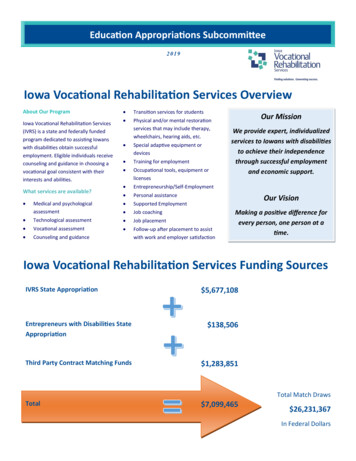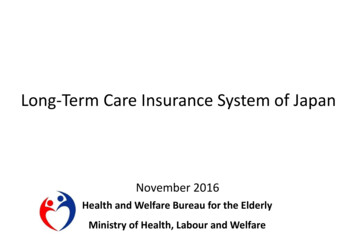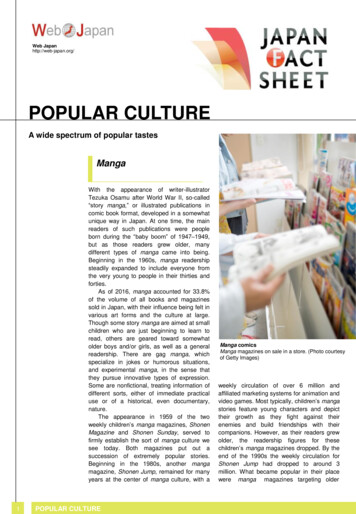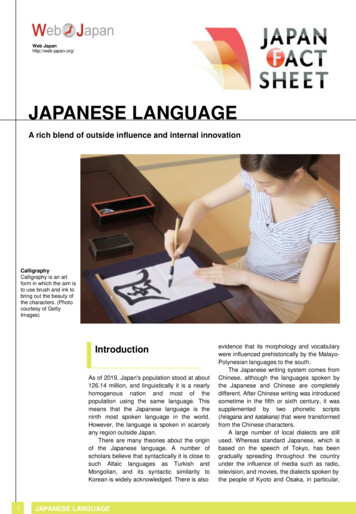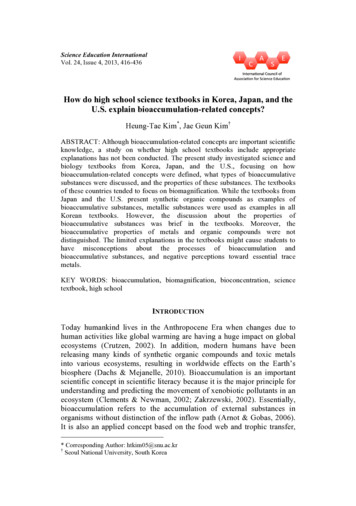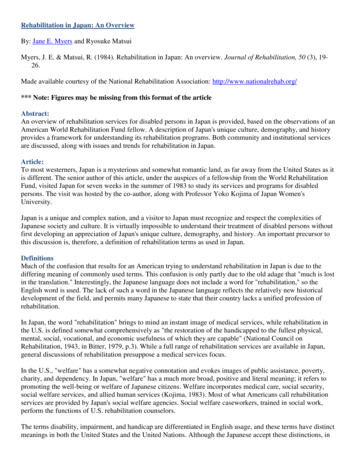
Transcription
Rehabilitation in Japan: An OverviewBy: Jane E. Myers and Ryosuke MatsuiMyers, J. E. & Matsui, R. (1984). Rehabilitation in Japan: An overview. Journal of Rehabilitation, 50 (3), 1926.Made available courtesy of the National Rehabilitation Association: http://www.nationalrehab.org/*** Note: Figures may be missing from this format of the articleAbstract:An overview of rehabilitation services for disabled persons in Japan is provided, based on the observations of anAmerican World Rehabilitation Fund fellow. A description of Japan's unique culture, demography, and historyprovides a framework for understanding its rehabilitation programs. Both community and institutional servicesare discussed, along with issues and trends for rehabilitation in Japan.Article:To most westerners, Japan is a mysterious and somewhat romantic land, as far away from the United States as itis different. The senior author of this article, under the auspices of a fellowship from the World RehabilitationFund, visited Japan for seven weeks in the summer of 1983 to study its services and programs for disabledpersons. The visit was hosted by the co-author, along with Professor Yoko Kojima of Japan Women'sUniversity.Japan is a unique and complex nation, and a visitor to Japan must recognize and respect the complexities ofJapanese society and culture. It is virtually impossible to understand their treatment of disabled persons withoutfirst developing an appreciation of Japan's unique culture, demography, and history. An important precursor tothis discussion is, therefore, a definition of rehabilitation terms as used in Japan.DefinitionsMuch of the confusion that results for an American trying to understand rehabilitation in Japan is due to thediffering meaning of commonly used terms. This confusion is only partly due to the old adage that "much is lostin the translation." Interestingly, the Japanese language does not include a word for "rehabilitation," so theEnglish word is used. The lack of such a word in the Japanese language reflects the relatively new historicaldevelopment of the field, and permits many Japanese to state that their country lacks a unified profession ofrehabilitation.In Japan, the word "rehabilitation" brings to mind an instant image of medical services, while rehabilitation inthe U.S. is defined somewhat comprehensively as "the restoration of the handicapped to the fullest physical,mental, social, vocational, and economic usefulness of which they are capable" (National Council onRehabilitation, 1943, in Bitter, 1979, p.3). While a full range of rehabilitation services are available in Japan,general discussions of rehabilitation presuppose a medical services focus.In the U.S., "welfare" has a somewhat negative connotation and evokes images of public assistance, poverty,charity, and dependency. In Japan, "welfare" has a much more broad, positive and literal meaning; it refers topromoting the well-being or welfare of Japanese citizens. Welfare incorporates medical care, social security,social welfare services, and allied human services (Kojima, 1983). Most of what Americans call rehabilitationservices are provided by Japan's social welfare agencies. Social welfare caseworkers, trained in social work,perform the functions of U.S. rehabilitation counselors.The terms disability, impairment, and handicap are differentiated in English usage, and these terms have distinctmeanings in both the United States and the United Nations. Although the Japanese accept these distinctions, in
their language all three terms are represented by one word, shogai. Obviously, translations of shags' fromJapanese to English can be variable and confusing if the exact meaning is not clarified. Moreover, whendiscussing disabled people in Japan, it is important to be clear as to which disabled people are meant. Differentlaws have been promulgated and some different services exist for those who are physically handicapped andthose who are mentally retarded. But since a law for the welfare of mentally ill persons does not exist, limitedservices are available to them.Disabled persons are evaluated, registered, and given a handbook that identifies them as having one of six levelsof impairment, with level one being the most severe. The six levels are linked directly to the type and extent ofservices that disabled persons may receive. For example, persons having a disability classified as level one mayreceive all necessary medical services, including hospitalization, surgery, and follow-up, prosthetics,transportation assistance, housing modifications, and purchase of equipment such as typewriters and adaptedappliances to enable them to live more independently. Persons having a disability classified as level six may beeligible only for limited medical care or medications.Demography and CultureIsolated by oceans, Japan's four major and almost 4,000 minor islands comprise a total area about the size ofMontana. Approximately one-fifth of the land area is usable for the 119 million inhabitants. Japan ranks seventhin the world in total population, and fourth in population density. Its life expectancies of 78.9 years for womenand 73.5 for men are the highest in the world. Japan's population is also aging more rapidly than that of anyother country.Among free world economies, the standard of living in Japan is second only to the U.S. A per capita income of 8,870 (compared to 11,535 in the U.S.) reflects the fact that almost all Japanese are middle class. Overall, theunemployment rate is less than 2%, aided by a customary lifetime employment policy among major employers(Japan Institute of Labor, 1982). Property values are high, especially along the coast from Tokyo to Hiroshima,where three-fourths of the population resides.Japan has a rigorous and effective educational system. Students attend school six days a week, eleven monthsper year. The literacy rate exceeds 99%. Children educated since World War II take English each yearbeginning in junior high school. By the time of high school graduation, almost all students can read and manycan understand oral communication in the international language (e.g. English), though far fewer are able orwilling to speak English fluently.Due to its long history of geographic isolation, Japan remains genetically and culturally homogeneous. Culturalvalues such as honesty, loyalty, and efficiency are uniformly ingrained, aided by the close proximity andcompact living space that are realities of Japanese life.One of the most significant and most visible aspects of Japanese culture is its socialization and orientation to thegroup. General concern and respect for others is reflected in the low crime rate, the absence of graffiti, and thepreservation of, as well as pride in, public properties. The extended family network, while slowly eroding as thepopulation migrates to the cities, still reflects a variety of deep, complex cultural mores that preserve theessential nature of a mass conforming, mutually caring society. Disabled and aged persons continue to be caredfor mainly within the family. According to the Ministry of Health and Welfare, only 7.4% of all disabledpersons live in single person households, while 46.4% live in nuclear families and 32.6% in three generationextended families (R. Matsui, personal communication, September 5, 1983). Thus, Japan's need for nursinghomes and other types of custodial care facilities is less than that of the U.S.An estimated 3% of Japan's population is disabled, compared to 10% in the U.S. This figure may be lowbecause some families still hide their disabled members due to fear of negative societal attitudes (Kojima,1983). A survey conducted by the Ministry of Health and Welfare in 1980 revealed that approximately2,000,000 persons were physically disabled. This includes 57% having various disabilities, 17% visually
disabled, 16% with auditory handicaps, and 10% having internal disorders (Izawa & Matsui, 1983). Internaldisorders are increasing most rapidly (an increase of 297% between 1970 and 1980). Physical disabilitiesincrease with age; 60.9% of all physically disabled persons are over age 50 and 41.7% are over age 60(Japanese Society for Rehabilitation of the Disabled [JSRD], 1980). The customary retirement age of 55, whichis only recently changing to age 60, leaves many older disabled individuals out of the labor force. The threeleading causes of death and major contributors to disability among older workers are cancer, stroke, and heartdisease, in descending order of prevalence. This prevalence is exactly opposite to the situation in the U.S.,where the order of the three major diseases is heart disease, stroke, and cancer.When physically disabled persons are classified by level, levels one and two, (i.e., the most severelyhandicapped persons) comprise 10.8 and 15.7% of the disabled population, respectively. The percentage inlevels three to six are 12.5, 17.8, 15.3, and 12.5%; 15.4% are classified as unknown. Persons having multipledisabilities are classified as levels one and two. In addition, an estimated 356,300 persons are mentally retarded.Of these, 43,700 are institutionalized, while 312,600 reside at home, of whom 170,900 are over age 18(Ministry of Health and Welfare, 1979). There is no registry for mentally ill persons; however, Kojima (1983)estimated that 1.4 million Japanese have mental illness.The employment rate of the general population in Japan is 68.8% and the rate for physically disabled persons isnow 54% (JSRD, 1980; Kulkarni, undated).The quota system, initiated in 1960 and revised in 1966 and 1976, has resulted in an increase in the percent ofemployed physically handicapped persons from 39.3% in 1965 to 44.1% in 1970 to the current 54% (Kulkarni,undated). The number of self-employed disabled persons exceeds that found in the general population. In 1973,45.7% of the physically disabled population compared to 31.1% of the non-disabled population was selfemployed. By 1981, these figures had become 35.1% and 17.4% respectively, indicating that the number ofself-employed disabled persons is now twice as much as the number of self-employed nondisabled persons. Theauthors were unable to locate similar statistics for mentally retarded and mentally ill persons.Employer attitudes have been a major barrier to employment of disabled persons, with notable improvementsmade since 1981. Japan, as a nation, supported the 1981 International Year of Disabled Persons. A massivepublicity campaign was successful in making the entire population aware of, and more favorably inclinedtoward, the needs of disabled people. Japan has one congressman who represents the needs of disabledindividuals in the Diet (congress). He was reelected in the last national election, held in June, 1983, with strongsupport from both disabled and nondisabled constituencies. This action is symbolic of the recent trend ofJapanese consciousness toward improving the welfare and well-being of disabled persons.History, Legislation and Administrative StructureIn many ways, the historical development of rehabilitation services in Japan paralleled that of the U.S. untilWorld War II. The first related legislation, enacted in the late 1800's, provided monies for persons in emergencysituations, including disabled individuals. The earliest attempts to rehabilitate disabled persons were aimed atsoldiers disabled during World War I (Kojima, 1978). Rehabilitation programs in Japan became firmlyestablished and began to grow after World War II as part of major national reconstruction efforts. The UnitedStates system was used as a model; however, it was modified to suit Japan's needs. In contrast to the U.S.,where new legislation is drafted by members of Congress and their aides, new legislation in Japan is actuallywritten by the Ministry that will be responsible for its implementation. This procedure eliminates possibleconfusion over the difference between the intent of a piece of legislation and its impact.The first piece of rehabilitation legislation passed after the war was the 1949 Law for the Welfare of thePhysically Handicapped. Additional laws were passed and subsequently amended, so that today rehabilitationmeasures are carried out under the auspices of some 18 major laws (Government of Japan, 1980). Kojima(1978) succinctly and accurately described the overall system as follows:
Today. no single and unified rehabilitation legislation exists, but a group of specialized rehabilitationlaws are independently meeting the multidimensional needs of the disabled under three majoradministrative channels, the Ministry of Health and Welfare, the Ministry of Education, and the Ministryof Labor by having an independent budget and vertical administrative structure (p.9).The various programs operated by the three ministries are implemented through governmental andquasigovernmental agencies on three levels. First is the national level, second the prefectual or state level, andlast the local level. Japan has 47 prefectures and 10 major cities having equal status to each prefecture.The Ministry of Education administers a variety of programs aimed at the education of handicapped children.Compulsory education for blind and deaf children (in special schools) was implemented in 1948. Separateschools were developed for children who were mentally retarded, orthopedically impaired, and otherwise healthimpaired (JSRD, 1980). Children were not required to enter these schools until 1979, nor were localgovernments required to establish such schools until that time.The Ministry of Health and Welfare (i.e., Koseisho) was established in 1948 and is responsible for theadministration of several major laws (Kojima, 1978), including the following: the Child Welfare Law (1947),the Daily Life Security Law (1950), the Law for Aid to War Wounded and Sick Retired Soldiers and WarBereaved (1952), the Law for Welfare of Physically Handicapped Persons (1949), The Law for Welfare ofMentally Retarded Persons (1960), and the Fundamental Law for Counter Measures for Mentally andPhysically Handicapped Persons (1970).The Koseisho serves three main functions (Koseisho, 1981); namely, to render health and medical services, toprovide social welfare services, and to administer social insurance programs.The Social Welfare Bureau, one of nine in the Koseisho, was established "to improve and promote the daily lifeand well-being of.marginal families, aged, and physically handicapped" (Koseisho, 1981, p.26). Some of themajor functions of this bureau include payment of public assistance, providing loans to low income families,providing institutional care for aged persons and home helpers for families of aged persons, arranging freemedical care for older persons, and providing "medical care and rehabilitation training for the physicallyhandicapped (blind, deaf/mute, physically handicapped.etc.) as well as providing such rehabilitation facilitiesand helpers who assist those handicapped" (Koseisho, 1981, p.26).The Rehabilitation Division within the Social Welfare Bureau is responsible for providing welfare services tophysically handicapped persons. These welfare services include medical treatment; provision and/or repair ofprosthetic appliances; rehabilitation examination and counseling (including in-home service for severelydisabled persons); promotion of sports events; encouraging the participation of community members inrehabilitation activities (i.e., training volunteers in braille typing and finger spelling); various in-home, chore,and attendant care services; providing subsidies for remodeling cars; and payment of costs associated withrehabilitation training. A variety of rehabilitation centers and facilities for physically handicapped persons arepart of this bureau's service delivery system. The Koseisho also operates institutions for the care of mentallyretarded children and adults, national homes for blind persons, and the National Rehabilitation Center for theDisabled. The latter center, established in 1979, is one of two national centers developed as a result of majorlegislation. The second is still under construction at this time.The Ministry of Labor also operates a variety of programs for disabled individuals. The major laws related tothese programs are the Workmen's Compensation Accident Compensation Law (1947), the EmploymentSecurity Law (1947), and the Physically Handicapped Persons Employment Promotion Law, passed in 1960and significantly amended in 1976. The 1960 law established a quota for employment of handicapped personsas a moral obligation of employers. The 1976 amendment made this a legal obligation with specified quotas bytype of industry (Izawa & Matsui, 1983).
The Ministry of Labor is directly responsible for some 473 local Public Employment Security Offices. Inaddition, the Ministry sponsors two quasigovernment agencies that have direct relevance to the needs ofhandicapped persons. First is the Employment Promotion Projects Corporation (EPPC) which oversees thequota system, collects levy monies amounting to some 18 billion yen annually ( 75,000,000), and administersgrants from these levy monies to employers who hire above the quota. Other programs of this corporationinclude the following: establishment and operation of basic and advanced vocational training centers, institutes,and colleges; providing loans for the modification of homes and worksites for disabled people; providingfinancial assistance for training, daily living, and transportation; assisting in coordinating retraining and new jobplacements to prevent unemployment among disabled workers; and establishing and operating vocationalevaluation and counseling centers for disabled persons (EPPC, undated).The National Association for Employment of the Handicapped, a second quasigovernment agency operatedunder the auspices of the Ministry of Labor, conducts a variety of activities to promote employmentopportunities for handicapped persons. These activities include offering training programs for employers andother individuals to help them better understand the needs of disabled persons, conducting research anddemonstration programs for the vocational development of disabled persons, sponsoring annual national as wellas international skill contests for disabled persons (Ambilympics), conducting an ongoing mass education campaign for employment of disabled persons, organizing overseas study tours and international exchangeprograms concerning the employment of disabled persons, and administering the National VocationalRehabilitation Center (National Association for Employment of the Handicapped, 1982).The Rehabilitation Process, Japanese StyleEach of the three ministries described above provides important services to facilitate the rehabilitation ofdisabled persons. In the United States, the state-federal system is designed so that one vocational rehabilitationcounselor is responsible for facilitating and monitoring the progress of disabled individuals toward vocationaland personal independence. In Japan, such a system does not exist. Rather, the progress of a client through thestandard rehabilitation process -- e.g., referral, evaluation, planning, medical services, counseling, training, jobplacement, successful case closure -- becomes the responsibility of many agencies. Realistically, interagencycoordination is not always optimum. The involvement of each agency may be clarified by relating them to therehabilitation process as defined in the U.S.New referrals come through the hospitals or (and eventually, anyway) local offices of the Ministry of Healthand Welfare. The latter offices send disabled persons to the Consultation Centers for the PhysicallyHandicapped, of which there is one per prefecture. These centers use a team evaluation to determine the natureand extent of the disabilities and services needed. The centers provide counseling; medical, psychological, andvocational evaluation; prescript
American World Rehabilitation Fund fellow. A description of Japan's unique culture, demography, and history provides a framework for understanding its rehabilitation programs. Both community and institutional services are discussed, along wit
